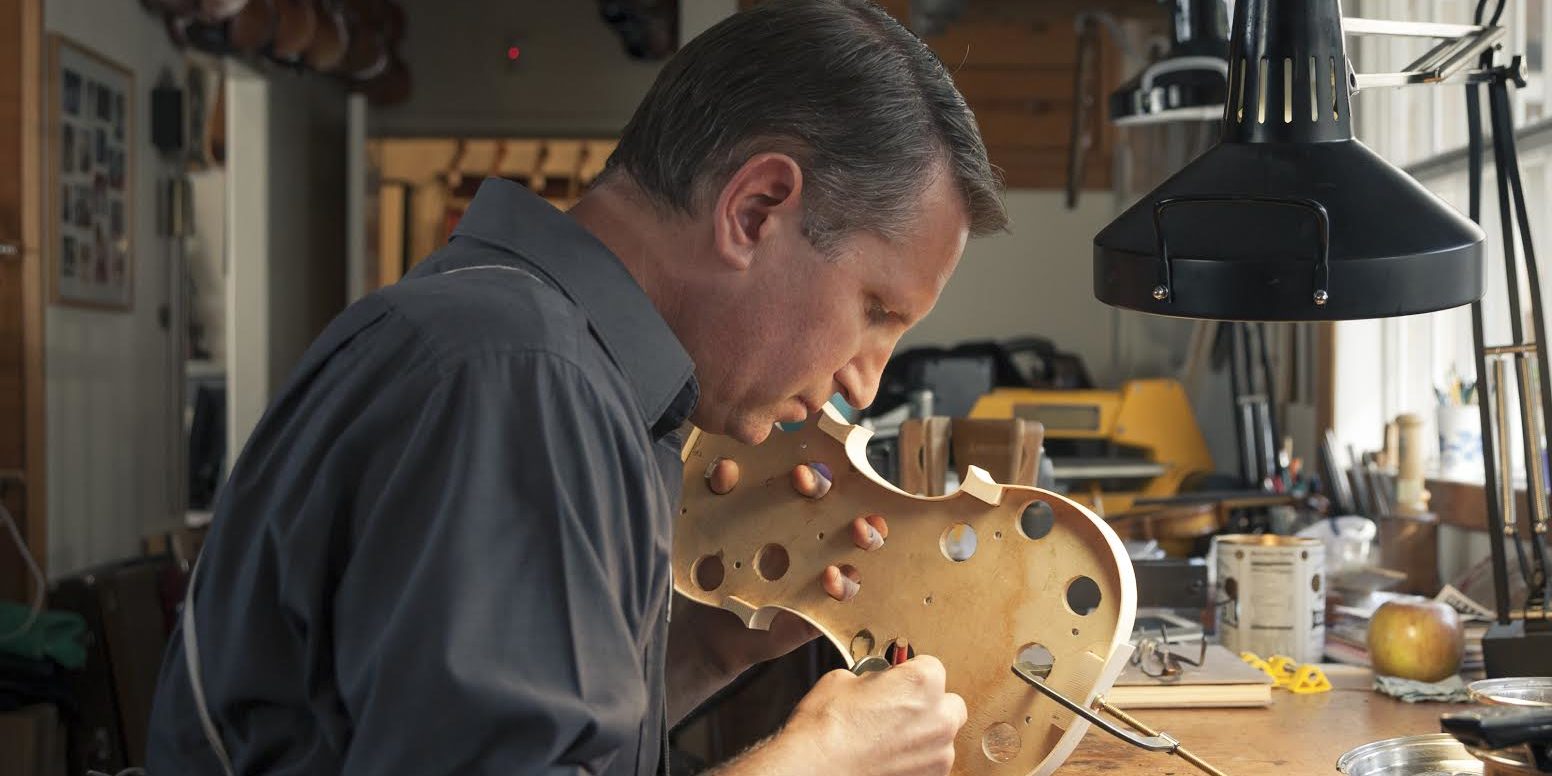Third-generation master violinmaker Eric Benning did not set out to become a star in what he calls “the golden age of modern American violinmaking.” Instead, he set out to be the best craftsman he could possibly be. Nevertheless, he is quickly achieving star status in the world of violinmakers, having crafted instruments for notable artists such as cellist Ronald Feldman, violinist Vijay Gupta, violinist Ashot Tigranyan, violinist Aleksandra Maslovaric, and violist Paul Coletti. Currently, four musicians in the Los Angeles Philharmonic play on Benning-crafted instruments. Eric works day in and day out, creating and maintaining the finest instruments, in the Benning Violins shop which has been run by his family for the past 6 decades. He has become an expert at meticulously crafting a caliber of violins, cellos, and violas that most musicians may not ever have the pleasure of playing. What he consistently finds in the midst of wood and tools and pressure to produce perfection is his heart and soul, both of which go into every instrument he makes or repairs.
Eric Benning’s instruments speak for themselves. (Head over to his shop located on Ventura Boulevard in Los Angeles if you want to discover this firsthand.) Today, the man himself speaks out about his experience as a master violinmaker: the highs and lows of it, his passions surrounding it, and his deep commitment to his craft. You will find Segmation’s exclusive interview with Eric located below.
Exclusive Interview with Master Violinmaker Eric Benning, Rising Star In the “Golden Age of Modern American Violinmaking”
Q) Do you remember the moment or period of time in which you knew you wanted to carry on the family tradition of becoming a Violinmaker? Tell us about it.
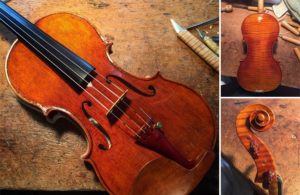 A) I would say around 9 or 10 years of age. That’s when I really felt like I knew this was what I wanted to do. I was obviously very naïve as to what it all would entail, but I knew that’s where my interest lied; especially in making new instruments. Something happened every time these things were put in front of me (wood or tools and things like that). I wanted to do something with them. This is something I was very passionate about at a very early age. In terms of understanding the full weight of this being a family tradition, I don’t know when I totally comprehended that. It happened over time. I eventually understood the gravity of being part of a multi-generational business that has a firmly established reputation. Now my own teenage son Nathan is going through the same process of understanding.
A) I would say around 9 or 10 years of age. That’s when I really felt like I knew this was what I wanted to do. I was obviously very naïve as to what it all would entail, but I knew that’s where my interest lied; especially in making new instruments. Something happened every time these things were put in front of me (wood or tools and things like that). I wanted to do something with them. This is something I was very passionate about at a very early age. In terms of understanding the full weight of this being a family tradition, I don’t know when I totally comprehended that. It happened over time. I eventually understood the gravity of being part of a multi-generational business that has a firmly established reputation. Now my own teenage son Nathan is going through the same process of understanding.
Q) As a master violinmaker, do you feel you have completely arrived in your art of crafting instruments? If not, what skill would you like to get stronger in?
A) I don’t think a good violinmaker ever feels like they’ve completely arrived. Probably no true artist ever feels this way. It’s not an “arrive at” thing. I think that would defeat the passion that drives makers and artists. I believe knowing that there is something still undone and things still to achieve within a craft/art is motivational.
If I felt like I had achieved everything and somehow had done it all then I’d probably find something else to do. In terms of what I’d like to be stronger at, I think every violinmaker struggles with varnish, antiquing, achieving certain looks. I see other people’s work and wonder how they accomplished certain things. There are specific aesthetics that I still want to achieve. As far as the sounds of my instruments go — I feel like I’ve got a good grip on how to achieve the sounds that I want. I feel like I can shape the sound to what I need. I have gotten pretty good at that. But there are certain things make me think, “Wow, if I could just get a little bit more of this or a little bit more of that.” I mean, this process is ever-evolving and ever-changing. It’s ongoing. I don’t think I’ll ever be satisfied. Hopefully.
Q) What was the most challenging aspect of your education in violinmaking? What aspect came the easiest for you?
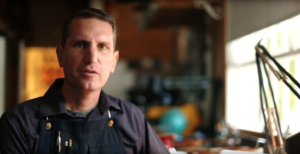 A) I think one of the most challenging parts of violinmaking for me is the fact that it is a very solitary craft. It is something I enjoy doing in my own world and in my own space. Learning from other makers and branching out and getting outside influence into my work — that is the most challenging aspect of violinmaking for me. I’m naturally a shy, sort-of-solitary person and I need my own quiet space. So to put myself out there and introduce myself to somebody and say, “Hey, would you mind showing me the way you do that?” is hard. Putting myself out there in terms of networking with other makers who will influence me is probably the hardest part of what I do. What comes easiest for me is the raw woodworking, the tool work, and creating a shape and sound that I desire. That has always come naturally to me.
A) I think one of the most challenging parts of violinmaking for me is the fact that it is a very solitary craft. It is something I enjoy doing in my own world and in my own space. Learning from other makers and branching out and getting outside influence into my work — that is the most challenging aspect of violinmaking for me. I’m naturally a shy, sort-of-solitary person and I need my own quiet space. So to put myself out there and introduce myself to somebody and say, “Hey, would you mind showing me the way you do that?” is hard. Putting myself out there in terms of networking with other makers who will influence me is probably the hardest part of what I do. What comes easiest for me is the raw woodworking, the tool work, and creating a shape and sound that I desire. That has always come naturally to me.
Q) What is your favorite part of the process of making a Benning violin? Which part do you find most relaxing? Which part is most energy-consuming?
A) My favorite part of making an instrument is finally cutting the outline out, which takes only 30-to-60 minutes. It’s a step that doesn’t take long, but it immediately produces an extremely visible result that shows me the entire outline of how the instrument will look and how the flames of the wood or figure of the wood will lay into a pattern.
Which part do I find most relaxing? That’s an interesting question. Maybe wood selection. Carving the scroll is really relaxing for me. Tasks related to raw woodwork and its craft and artistry relax me because I feel confident in those aspects of my craft.
What is most energy-consuming? That would be making a cello. Arching a cello. Graduating a cello. That’s when you get the big chisels out. That uses the most energy, at least physically. Mental energy gets used when I’m doing the arching and graduating, but in a different respect than what you might think. My mental energy gets drained not when I have the big chisel out, but when I’m actually doing the fine thinning of the wood to its final thicknesses and shapes. That’s mentally taxing simply because it dictates and shapes the sound. So I spend a great deal of time on that. My making absolutely certain that I’m creating the sound I’m looking for is what consumes most of my mental energy.
Q) What do you want the violins you create to say about who you are as an artist?
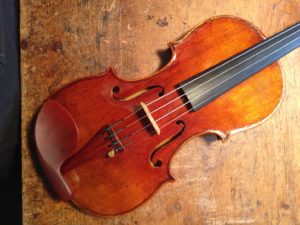 A) Violinmaking is considered to be a fine art. Making a fine instrument implies that the maker has mastered the fine details. It implies that the maker’s workmanship is precise and clean, not sloppy. My great-uncle Carl Becker, a world-renowned violinmaker and my mentor, was fastidious, certain, and sure of everything he did. I admired that approach to craftsmanship and have tried to emulate it. As it turns out, I’m also that way. It’s a hard trait to learn if it doesn’t come naturally.
A) Violinmaking is considered to be a fine art. Making a fine instrument implies that the maker has mastered the fine details. It implies that the maker’s workmanship is precise and clean, not sloppy. My great-uncle Carl Becker, a world-renowned violinmaker and my mentor, was fastidious, certain, and sure of everything he did. I admired that approach to craftsmanship and have tried to emulate it. As it turns out, I’m also that way. It’s a hard trait to learn if it doesn’t come naturally.
I hope that in the future, when other makers look at my instruments and open them up, they will think, “This maker spent a lot of time getting this right and getting that right. This maker was attentive to the small but important details. He was mindful and knew what he wanted.” I want them to think this not just in regards to either sound or aesthetics, but to the entire package. I think similar thoughts and, of course, opposite thoughts about instruments that aren’t mine (those I repair and maintain for my clients). I can see when a maker was sloppy, when he didn’t care, and when he was having a bad week and probably shouldn’t have been working on an instrument.
Not surprisingly, when you see a poorly conceived and constructed instrument, the temptation is to care as much about the instrument as the maker did. I want these future makers to know I cared and that I carefully considered my work and executed the making with passion and skill. Hopefully, they’ll treat my instruments as I did. Really, that’s probably the secret to how these fine master-crafted instruments have survived over many hundreds of years.
Q) Tell us about one of your favorite violins that you were commissioned to make.
 A) I have a top-ten list. The one freshest in my mind is an instrument I’m making right now. It’s a copy of a viola by Peregrino Di Zanetto from the year 1545. That, in and of itself, is quite astounding (that I have an instrument on my bench that’s over 500 years old). And now I’m being asked to make a copy of it. It’s completely different than the style I normally make. It has double perfling, it has inlays, it has an extremely different shape and outline, and the carving of the scroll is unique. It’s fun and challenging to do something that stretches me and shows me new ways to approach things. I’m using different tools than I normally would in order to achieve the results I want, so this is one of the more enjoyable commissions that I’ve been asked to make.
A) I have a top-ten list. The one freshest in my mind is an instrument I’m making right now. It’s a copy of a viola by Peregrino Di Zanetto from the year 1545. That, in and of itself, is quite astounding (that I have an instrument on my bench that’s over 500 years old). And now I’m being asked to make a copy of it. It’s completely different than the style I normally make. It has double perfling, it has inlays, it has an extremely different shape and outline, and the carving of the scroll is unique. It’s fun and challenging to do something that stretches me and shows me new ways to approach things. I’m using different tools than I normally would in order to achieve the results I want, so this is one of the more enjoyable commissions that I’ve been asked to make.
Q) What three words best describe you as an artist? Why those words?
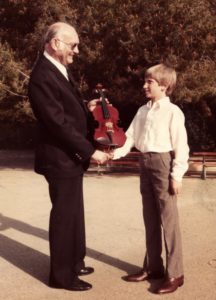 A) That’s a hard one. Maybe the word “humbled” and for sure “appreciative.” They go hand in hand. Anyone is fortunate to be able to pursue art or a craft as a full-time occupation, and one is extremely fortunate to achieve any recognition or success within their craft. None of this is lost on me. When I’m in my shop working on a renowned instrument made by one of the Italian masters, I feel a great deal of wonder and awe and gratitude. That’s the state I want to be creating from myself. As I said before, I want future makers to see my work and conclude that I was caring in my approach to my craft. Having talent and having ability in a craft is never quite enough. There has to be a great deal of caring for the sake of the work itself. Caring is what drives a maker to consider everything that needs to be considered to create something of quality.
A) That’s a hard one. Maybe the word “humbled” and for sure “appreciative.” They go hand in hand. Anyone is fortunate to be able to pursue art or a craft as a full-time occupation, and one is extremely fortunate to achieve any recognition or success within their craft. None of this is lost on me. When I’m in my shop working on a renowned instrument made by one of the Italian masters, I feel a great deal of wonder and awe and gratitude. That’s the state I want to be creating from myself. As I said before, I want future makers to see my work and conclude that I was caring in my approach to my craft. Having talent and having ability in a craft is never quite enough. There has to be a great deal of caring for the sake of the work itself. Caring is what drives a maker to consider everything that needs to be considered to create something of quality.
Q) What sets Benning Violins apart from the competition?
A) In terms of who I’m in competition with, I can tell you that I’m not competing with student models or factory-made instruments, which comprise the majority of violins out there. I’m in competition with other makers of my caliber. This is a golden age of modern American violinmaking, and there are a lot of great contemporary makers that I admire and respect.
To the layman, violins look the same. However, to the trained eye and ear, violins are vastly different. Every maker has his own wood, his own varnish recipe, his own formula, and his own approach. Musicians looking to acquire a new instrument have their own idea of what they want. Do they want a rich, dark tone? Do they want a very bright-sounding violin? Do they want a dark varnish or a red varnish? Do they want a little more of this or a little less of that? Their tastes vary quite a bit. This is consistently true across all fine art mediums. Some people are going to think you created a masterpiece and someone else might think the opposite. That’s basically the process. So in that sense, we makers aren’t in competition with one another. And when we understand it that way, we can’t get offended or take it personally if a musician doesn’t appreciate what we’ve crafted. There’s always going to be another that does.
Eric Benning is an artist to the core. To fulfill his calling and passion, he relies on the artistic abilities he was gifted with. Without them, he would be unable to do what he was made to do, which is to bless the world with Benning-crafted instruments.
Interested in learning more about Benning Violins? We suggest checking out the shop’s website, following Benning Violins on Twitter, or sending an email to info@benningviolins.com. Watch Eric Benning in action on A&E’s “Storage Wars,” and don’t forget to take a look at CBS’s “CSI Cyber” video which features Benning Violins.
Note: The first 6 images in this blog post are the property of Benning Violins. Segmation has express permission from Benning Violins to use these photos. They are not for reuse.
Read More of Segmation’s Artist Interviews:
How to Live an Artist’s Dream: a Tale of Two Brothers
Segmation’s Interview with Artist Edgars Būmeisters
See Personal Color Analysis (PCA) Through the Eyes of Color Analyst Cate Linden

Check out Segmation’s Music-mation!
(Image via pixabay.com)
Be an Artist in 2 minutes with Segmation SegPlay® PC Music-mation (see more details here)
Join SegPlay® Mobile on iTunes now available for iPhone and iPad
